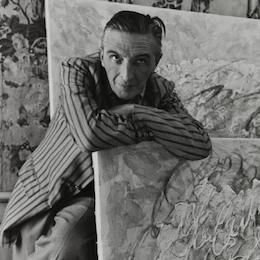Jean Fautrier
1898 (Paris) / 1964 (Châtenay-Malabry)
A portrait of Jean Fautrier by Yves Peyré illuminates the singularity of his artistic development. "The allure of a mountain man, the unshakeability of a sailor, the appearance of a warrior... arousing the legendary by the mere fact of existing, while lighting counterfires to remain in the shadows... Standing in the turbulence of the century... seeking, finding, giving. Alone on the path of oneself. Like these men that the poet Jean-Paul calls the burned of the life.
What Fautrier himself confirms in his biographical letter of 1944 to his writer friend Jean Paulhan, patron of the NRF, who did much for the notoriety of the artist after the war, especially with his essay Fautrier l'enragé (1949). Paulhan considered him to be "the only painter since Braque who knows what the material of a painting is and what to do with it", and introduced him to the poet Francis Ponge. Fascinated by the man and his work, Ponge devoted several texts to him - evoking, for example, "his sense of grandeur and risk, truly princely, an elegance at least equal to that of Manet, his taste for high ceremony and a sensuality of which no sign has been seen in France since the reign of the Great Bearnais.
A portrait of Jean Fautrier by Yves Peyré illuminates the singularity of his artistic development. "The allure of a mountain man, the unshakeability of a sailor, the appearance of a warrior... arousing the legendary by the mere fact of existing, while lighting counterfires to remain in the shadows... Standing in the turbulence of the century... seeking, finding, giving. Alone on the path of oneself. Like these men that the poet Jean-Paul calls the burned of the life.
What Fautrier himself confirms in his biographical letter of 1944 to his writer friend Jean Paulhan, patron of the NRF, who did much for the notoriety of the artist after the war, especially with his essay Fautrier l'enragé (1949). Paulhan considered him to be "the only painter since Braque who knows what the material of a painting is and what to do with it", and introduced him to the poet Francis Ponge. Fascinated by the man and his work, Ponge devoted several texts to him - evoking, for example, "his sense of grandeur and risk, truly princely, an elegance at least equal to that of Manet, his taste for high ceremony and a sensuality of which no sign has been seen in France since the reign of the Great Bearnais.
Artist's exhibitions
Jean Fautrier - Matière et lumière
26/01/2018 - 20/05/2018
(Paris) Musée d'Art Moderne de la Ville de Paris
26/01/2018 - 20/05/2018
(Paris) Musée d'Art Moderne de la Ville de Paris
